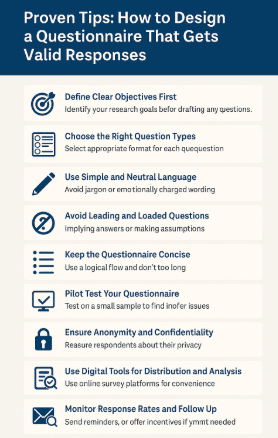
If you're conducting research, writing a thesis, or launching a feedback survey, knowing how to design a questionnaire that gets valid responses is crucial. A well-designed questionnaire ensures the reliability and credibility of your findings, while a poorly structured one can lead to ambiguous or misleading results.
In this post, we’ll walk through step-by-step strategies for creating effective, targeted, and valid questionnaires—whether you're in academia, marketing, education, or public policy.
Using Case Studies to Drive Business Growth: Strategies and Examples
Why Valid Responses Matter
Designing a questionnaire isn’t just about asking questions—it’s about asking the right questions in the right way. Valid responses are those that accurately reflect the opinions, knowledge, or experiences of your respondents. They’re essential for:
- Drawing meaningful conclusions
- Supporting evidence-based decisions
- Avoiding bias or skewed results
- Enhancing the credibility of your research
1. Define Clear Objectives First
Before drafting any questions, clearly define your goals. What exactly are you trying to find out? Your questionnaire should be aligned with your research objectives.
Example:
If your research objective is to assess student satisfaction with online learning, your questionnaire should focus on key themes such as teaching quality, access to resources, and interaction with faculty.
Avoid including unrelated questions that dilute the purpose of your instrument.
2. Choose the Right Question Types
Understanding question types is key to learning how to design a questionnaire that gets valid responses.
- Closed-ended questions provide structured data (e.g., multiple choice, rating scales).
- Open-ended questions offer qualitative insights (e.g., short written responses).
- Likert scale questions help measure attitudes or perceptions.
- Demographic questions help segment and analyse responses by group.
Tip: Use closed questions for quantitative data and open questions sparingly for depth.
3. Use Simple and Neutral Language
To ensure validity, your questions must be easy to understand. Avoid technical jargon, double-barrelled questions, or emotionally charged wording.
Poor Example:
“How satisfied are you with the course content and the instructor's attitude?”
Improved Version:
“How satisfied are you with the course content?”
“How satisfied are you with the instructor’s attitude?”
Keep wording neutral to avoid influencing responses.
4. Avoid Leading and Loaded Questions
Leading questions imply a desired answer, while loaded questions assume something that may not be true. Both compromise the validity of your data.
Example:
Leading: “Don’t you think our new app is easy to use?”
Loaded: “What improvements would you make to our app, since it’s difficult to navigate?”
Better: “How easy or difficult was it to navigate our new app?”
5. Keep the Questionnaire Concise
Long, repetitive questionnaires lead to survey fatigue and lower response quality. Aim for a logical flow of questions and keep the length reasonable.
Best Practice:
- Group similar topics together
- Move from general to specific
- Place sensitive or demographic questions at the end
6. Pilot Test Your Questionnaire
Before rolling out the full survey, conduct a pilot test with a small group similar to your target population. This helps identify:
- Confusing or ambiguous questions
- Technical issues (if online)
- Time taken to complete
- Areas for improvement
Make necessary revisions based on feedback.
7. Ensure Anonymity and Confidentiality
To increase honesty in responses, especially for sensitive topics, reassure participants of anonymity and confidentiality.
Example Statement:
“Your responses will remain anonymous and will only be used for research purposes.”
This encourages candid participation and enhances data validity.
8. Use Digital Tools for Distribution and Analysis
Online platforms like Google Forms, Microsoft Forms, Qualtrics, or SurveyMonkey offer built-in logic, response validation, and auto-analysis features.
Tip: Set questions as “required” when necessary to avoid missing data, and randomise options when order bias might occur.
9. Monitor Response Rates and Follow Up
A good response rate improves the representativeness of your data. Send reminders, use engaging language in invitations, and offer incentives if appropriate.
Tip: A response rate above 60% is considered strong for most research projects.
10. Analyse and Interpret with Caution
Once responses are collected, analyse results in the context of your objectives. Be mindful of:
- Non-response bias
- Incomplete answers
- Contradictory responses
Use statistical or thematic analysis tools to identify trends, correlations, and insights.
Conclusion
Understanding how to design a questionnaire that gets valid responses is essential for any researcher or professional relying on survey data. It requires thoughtful planning, precise language, pilot testing, and continuous refinement.
By following these strategies, your questionnaire will not only yield accurate and valid results—it will also enhance the credibility and impact of your research or project.
Would you like a professional visual to complement this blog post and explain these steps at a glance?
Visit The Case HQ for 95+ courses
Read More:
Exploring the Real-World Impact of Case Studies in Urban Planning
Breaking Down a Case Study: An Interactive Walkthrough
How to Cite Case Studies and Research Publications in Your Work
The Intersection of Ethics and Case Studies in Research
The Influence of Case Studies on Public Policy Development
Understanding the Importance of Case Studies in Modern Education
How to Write a Compelling Case Study: A Step-by-Step Guide
The Role of Research Publications in Shaping Business Strategies
The Impact of Real-World Scenarios in Business Education
The Power of Field Case Studies in Understanding Real-World Businesses
https://thecasehq.com/proven-tips-how-to-design-a-questionnaire-that-gets-valid-responses/?fsp_sid=1161
Comments
Post a Comment